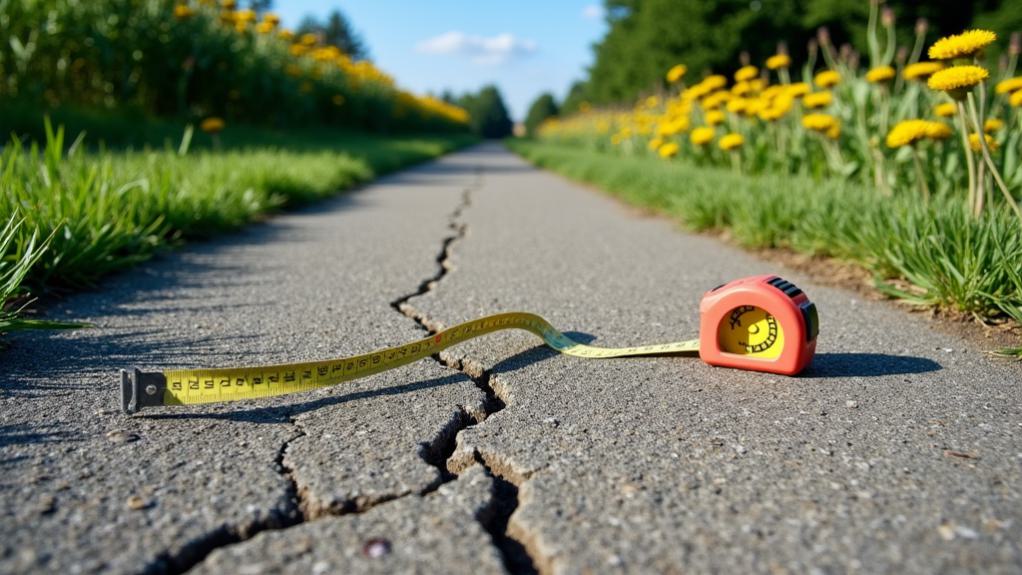You should consider repaving your asphalt driveway if you notice severe damage, such as over 30% showing significant cracks, or alligator cracking indicating underlying issues. Potholes are another clear sign that drainage problems need addressing. If your driveway is over 20 years old, it’s time to assess for significant wear.
Regular inspections help identify issues early, extending its lifespan. Neglecting repairs may lead to higher costs later. By keeping an eye on these indicators, you’ll manage maintenance effectively and protect your investment. There’s more to understand about maintaining your asphalt driveway properly.
Key Takeaways
- Repave if over 30% of the driveway shows significant damage, such as large cracks or alligator cracking.
- Address potholes immediately, as they indicate drainage or base problems that may require repaving.
- Consider repaving for driveways older than 20 years, as they may exhibit significant wear.
- Assess foundation stability if there are signs of sinking or shifting, as this may necessitate repaving.
- Regular inspections can help determine if surface wear warrants repair or complete repaving.
Understanding Asphalt Driveway Lifespan

Over the years, understanding the lifespan of your asphalt driveway becomes crucial for effective maintenance. Typically, asphalt driveways last between 15 to 30 years, influenced by factors such as climate, usage, and maintenance practices.
If you take good care of your driveway, it can reach the higher end of that lifespan, while neglect might force you to replace your driveway sooner—around the 15-year mark. Regular inspections are essential, and opting for high-quality service can help guarantee your driveway remains in good condition.
Look for signs of distress, such as large cracks or alligator cracking that affects more than 30% of the surface. Significant potholes can also indicate underlying drainage issues that need addressing. Proper maintenance, which includes timely repairs, can help you avoid premature repaving.
If your asphalt driveway shows minor surface problems but maintains a stable underlying structure, resurfacing can extend its life by an additional 8 to 15 years.
Ultimately, the longevity of your asphalt driveway hinges on your attention to its condition. By staying proactive and addressing issues early, you maximize its lifespan and delay the need to replace your driveway.
Key Indicators for Repaving
Recognizing the key indicators for repaving your asphalt driveway is essential for maintaining its integrity and appearance. If more than 30% of your driveway displays significant damage or large cracks, it’s a strong sign that you need to repave.
Look out for alligator cracking; this pattern of interconnected cracks indicates severe underlying issues, often requiring more than simple asphalt repair. Additionally, if you notice that your driveway has become increasingly difficult to maintain, it may be time to contemplate professional asphalt paving services to restore its condition.
Potholes or deep depressions are another critical indicator; they can signal drainage or base problems that necessitate repaving to address these root causes.
If your driveway has multiple layers of asphalt, this may suggest past resurfacing attempts. A professional inspection can help determine if repaving is the best option.
Importance of Regular Inspections
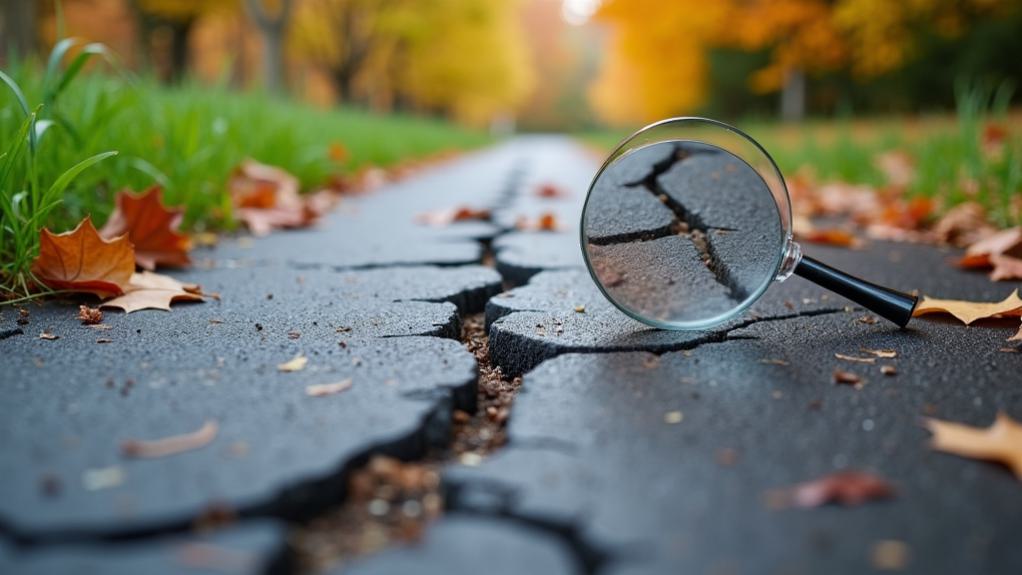
How often do you think about the condition of your asphalt driveway? Regular inspections are vital for maintaining the integrity of your driveway and avoiding costly repairs or premature repaving. It’s recommended to check your driveway at least once a year, especially after severe weather. This way, you can catch issues like small cracks or potholes before they escalate.
| Inspection Focus | Importance |
|---|---|
| Surface Damage | Identifies small cracks early |
| Foundation Stability | Guarantees sub-base is intact |
| Drainage Issues | Prevents future damage |
During these inspections, evaluate the foundation stability, as compromised conditions could lead to the need for repaving instead of simple resurfacing. Additionally, checking for drainage problems—like standing water or improper slope—can extend your driveway’s lifespan. By addressing minor issues promptly, you could potentially prolong the life of your driveway by 8 to 15 years. Remember, proactive inspections not only save you money but also enhance the durability of your asphalt surface. Don’t wait until it’s too late; make inspections a priority!
Effects of Weather on Asphalt
Weather plays an essential role in the performance and longevity of your asphalt driveway. Cold temperatures can cause asphalt to harden too quickly, complicating the pouring process. If temperatures drop below 50°F, you risk severe surface damage.
Ideally, you should aim for an ambient temperature between 70°F and 90°F during installation, as this range promotes proper compaction and prevents rapid hardening. Regular sealcoating can also protect against weather-related wear and tear, extending the lifespan of your driveway by 30-50% compared to unsealed asphalt extending asphalt lifespan.
Wet conditions, like early spring rainfall or melting snow, can also compromise your asphalt’s structural integrity. Water infiltration can damage the underlying base layers, leading to potential issues down the line.
Paving on damp surfaces exacerbates these problems, causing rapid cooling of the asphalt, which hinders proper adhesion and increases the likelihood of premature damage.
To maximize the lifespan of your asphalt driveway, seasonal planning is vital. Late spring to early fall typically offers the best weather conditions for laying asphalt.
If you’ve noticed significant wear and tear, understanding these weather-related factors can help you determine when it might be time to replace an asphalt driveway. Always consider these elements to guarantee your asphalt remains durable and effective.
Signs of Surface Wear
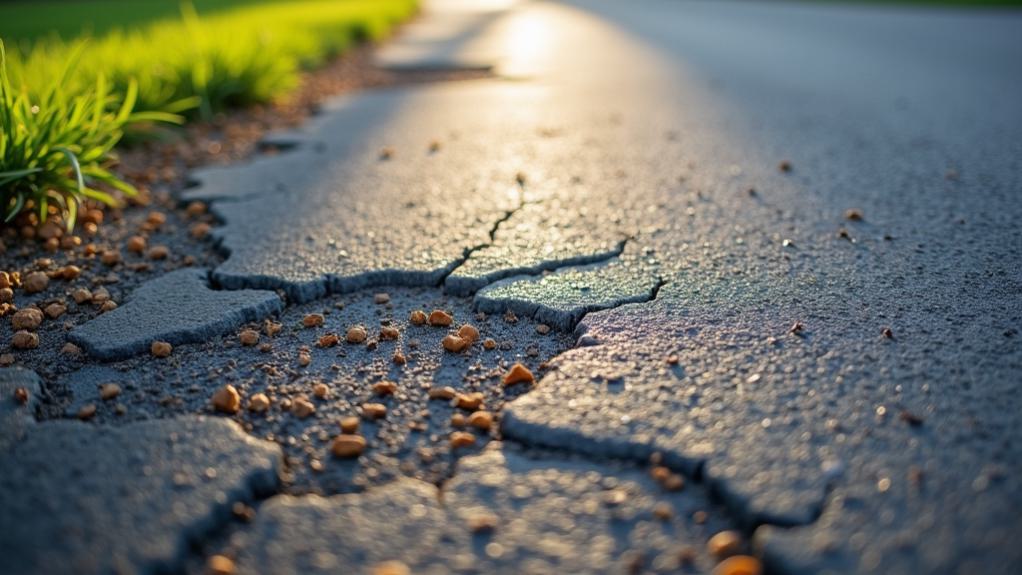
Surface wear on your asphalt driveway can manifest in several noticeable ways, signaling the need for attention.
Recognizing these signs of surface wear is essential for maintaining your driveway’s integrity and avoiding costly repairs. Here are three key indicators:
1. Cracking: If you see small, superficial cracks that are less than 1/4 inch wide, these can often be sealed.
However, deep cracks or alligator cracking generally indicate significant damage requiring repaving.
2. Potholes: The appearance of potholes is a clear sign that your asphalt’s structural integrity has been compromised.
This often stems from underlying drainage issues and usually necessitates repaving.
3. Surface Condition: If your driveway has multiple layers of asphalt and shows significant wear, it may indicate that the underlying layers are failing.
Additionally, if the driveway is over 20 years old and exhibits severe cracking, fading, or crumbling, it’s time to evaluate repaving for both safety and aesthetics.
Cracks and Their Implications
Cracks in your asphalt driveway can signal deeper issues that may require immediate attention. Understanding the type and extent of these cracks is essential in deciding whether to repair or repave. Here’s a quick reference table to help you assess the situation:
| Crack Type | Description | Action Required |
|---|---|---|
| Small Superficial | Minor, surface-level cracks | Repair with resurfacing |
| Large/Deep | Significant cracks indicating severe damage | Consider repaving |
| Alligator Cracking | Interconnected cracks like alligator skin | Complete repaving |
| Water Infiltration | Cracks allowing moisture to penetrate | Immediate repair needed |
If more than 30% of your driveway shows cracks, repaving is generally the best option. Ignoring these signs can lead to more extensive damage, especially in colder weather when water expands in cracks. Regular inspections are key—catching crack severity early can save you from costly repairs down the line. By staying proactive, you can determine whether you need resurfacing or full repaving for your asphalt driveway.
Evaluating Structural Integrity
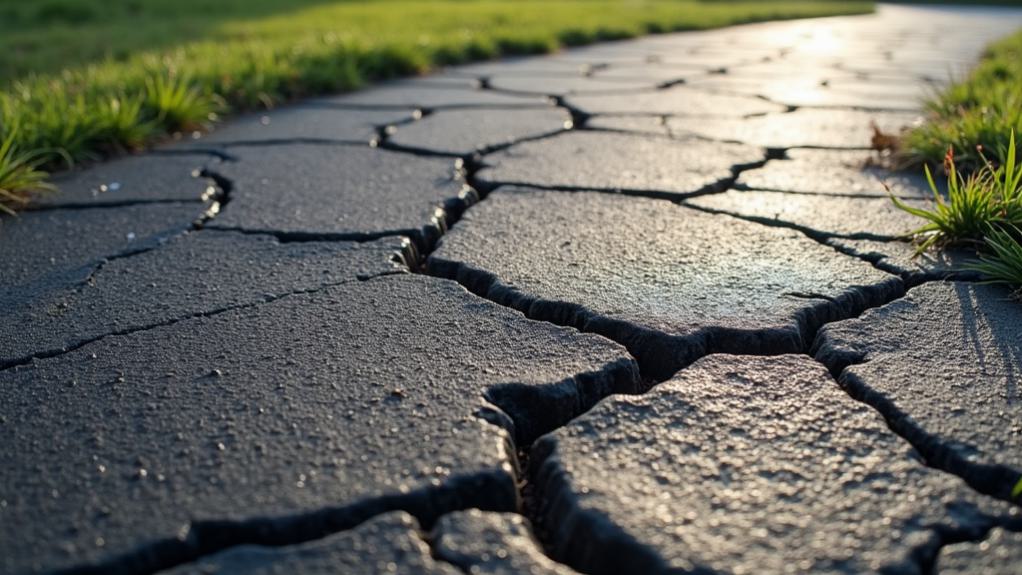
After addressing the various types of cracks in your driveway, it’s important to evaluate the overall structural integrity. This assessment can reveal whether repaving is necessary or if simple repairs will suffice.
Here are three critical factors to take into account:
- Foundation Stability: Check for any signs of sinking or shifting. These issues may indicate underlying problems that require immediate attention and potential repaving.
- Severe Cracking: Look for alligator cracking, which affects more than 40% of your driveway’s surface. If you observe this type of damage, a complete replacement is likely necessary rather than just repairs.
- Potholes: Inspect for the presence of potholes. If left untreated, they can worsen over time, compromising the structural integrity of your driveway and necessitating prompt repaving.
Additionally, take into account the age of your driveway. If it’s over 20 years old and shows significant wear, repaving might be the best option.
Cost Analysis for Repaving
When considering the costs associated with repaving your asphalt driveway, it’s essential to understand various influencing factors. The average cost for repaving is about $2.25 per square foot, but it can vary based on your location and the size of your driveway. For a standard 480 square foot driveway, you can expect to spend between $1,080 and $1,200. This cost analysis shows that repaving is often more economical than a complete replacement, potentially saving you significant amounts over time.
Here’s a quick breakdown of costs to help you grasp the financial aspects:
| Factor | Average Cost per Square Foot | Total Cost for 480 sq ft |
|---|---|---|
| Basic Repaving | $2.25 | $1,080 – $1,200 |
| Additional Repairs | Varies | +$200 – $500 |
| Replacement (if needed) | $4.00 – $8.00 | $1,920 – $3,840 |
Investing in timely repaving can extend your driveway’s lifespan by 20 years or more, making it a smart financial decision for homeowners.
Long-Term Maintenance Strategies
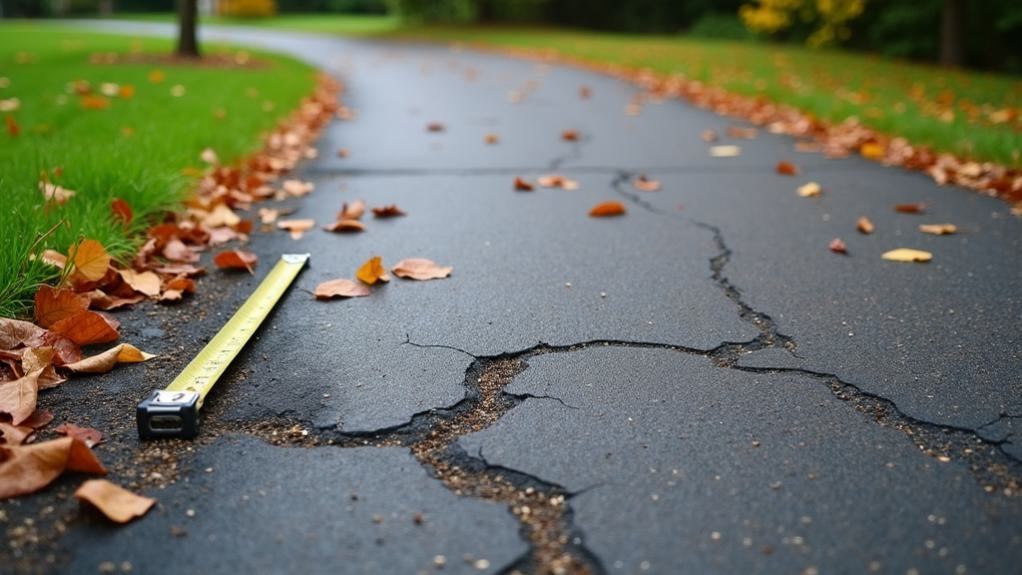
Understanding the costs associated with repaving your asphalt driveway sets the stage for effective long-term maintenance strategies.
To prolong the lifespan of your driveway and minimize expensive repairs, consider the following:
1. Conduct Regular Inspections: Every one to two years, check for signs of wear, like deep cracks or potholes. Addressing these issues early can help you avoid the need to repave your driveway prematurely.
2. Implement Regular Sealcoating: Apply sealcoating every 3 to 5 years. This protective layer helps delay the need for repaving by shielding the asphalt from water infiltration and UV damage.
While it won’t eliminate the eventual requirement to repave, it greatly extends the life of your driveway.
3. Monitor Seasonal Conditions: Be aware of how seasonal changes, particularly freeze-thaw cycles, can impact your asphalt.
If significant damage or alligator cracking affects more than 30% of your driveway, it’s a strong indicator that repaving is necessary.
Professional Assessment Recommendations
Proper assessment is essential for maintaining the integrity and longevity of your asphalt driveway. A professional assessment is important when over 30% of your driveway requires repairs or shows large cracks. This evaluation helps determine whether you need to take into account repaving.
Inspecting the foundation stability is key, as underlying issues can greatly affect the durability of any new surface.
If you notice alligator cracking, which indicates that more than 40% of the surface is compromised, it’s a strong signal that repaving is necessary rather than just resurfacing. For driveways with multiple asphalt layers, a professional should conduct a thorough inspection to evaluate the potential for full replacement versus resurfacing.
Regular evaluations by a professional can identify early signs of distress, ensuring timely intervention. This proactive approach not only addresses existing problems but also extends the overall lifespan of your driveway.
Don’t wait for visible damage to escalate; schedule a professional assessment to keep your driveway in ideal condition and avoid costly repaving in the future. Proper maintenance starts with understanding when a professional evaluation is needed.
Conclusion
In summary, knowing when to repave your asphalt driveway is essential for maintaining its integrity and appearance. By keeping an eye out for key indicators like surface wear, cracks, and structural issues, you can prevent costly repairs down the road. Regular inspections and understanding how weather affects your driveway will help you make informed decisions. Coincidentally, investing in timely maintenance not only enhances curb appeal but also extends the lifespan of your driveway, saving you time and money in the long run.
